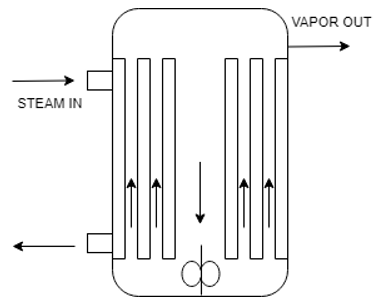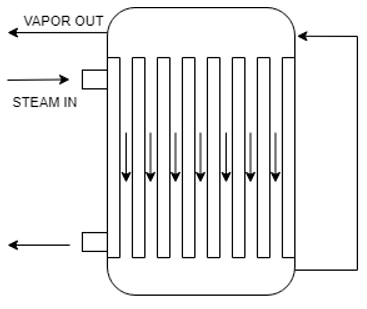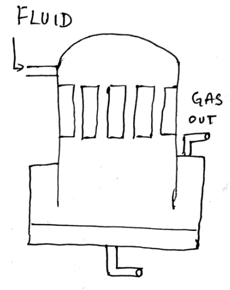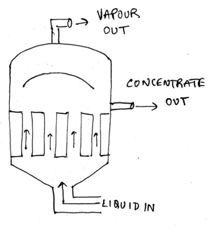This set of Advanced Heat Transfer Operations Questions and Answers focuses on “Falling Film Evaporator”.
1. Falling film evaporators are a subclass of long tube evaporators.
a) True
b) False
View Answer
Explanation: Falling film evaporators are a subclass of long tube evaporators along with Climbing film evaporators.
2. Falling film evaporators can be operated in _______________
a) Counter-flow with the vapour
b) Co-current flow with vapour
c) Both co-current and counter-current
d) Separate segments in any direction
View Answer
Explanation: The rotor used to remove the vapour from the film can be installed anywhere at the top or bottom which enables us to have either co-current or counter-current operations with the vapour.
3. Falling film evaporators are considered over climbing film evaporators because of which one of the following factor?
a) Efficiency
b) Product holdup
c) Driving force requirement
d) Temperature sensitivity
View Answer
Explanation: Falling film evaporators are normally selected in place of the rising film evaporators because both are having same advantages as rising film evaporators and it also has additional benefits of efficiency. There is an independence of driving force in falling films that make it more fruitful.
4. The applications of falling film and rising film are more or less same, but if industries have the cost capital, they go for falling film, why?
a) It has high temperature gradient and natural convection
b) Better efficiency of falling film
c) It has less temperature gradient and natural convection
d) No need for upward pressure
View Answer
Explanation: Falling film evaporators are normally selected in place of the rising film evaporators because both are having same advantages as rising film evaporators and it also has additional benefits of efficiency. There is an independence of driving force in falling films that make it more fruitful.
5. Falling film evaporators are best suited for pharmaceutical industries because
a) It has high temperature gradient and natural convection
b) Low pressure
c) It has less temperature gradient and natural convection
d) High headroom available
View Answer
Explanation: Falling film evaporators are normally selected in place of the rising film evaporators because both are having same advantages as rising film evaporators and it also has additional benefits of efficiency. There is an independence of driving force in falling films that make it more fruitful and less damaging. Rising films as well a falling films are widely used in pharmaceutical industries.
6. Falling film evaporators can be used with the fluid falling over
(i) Plates
(ii) Coils
(iii) Horizontal tubes
(iv) Vertical tubes
a) (i)(ii)(iii)
b) (i)(ii)
c) (i)(iii)(iv)
d) (i)(ii)(iii)(iv)
View Answer
Explanation: The falling film evaporator can be used in several possible ways, few of which can be noted when the fluid flows outside the tube and inside the tube, in both the cases there is fully developed film for evaporation to take place. The surface can be a tube, a coil, a plate, or even a horizontal tube.
7. Falling film evaporators have __________ product holdup.
a) Large
b) Very high
c) Low
d) Zero
View Answer
Explanation: The falling film does not accumulate unnecessarily the fluid at the top as well as at the bottom, hence the product holdup here is very low.
8. Which one of the following is not an advantage of falling film evaporator?
a) Relatively low cost
b) High headroom
c) Large surface area for heating available
d) Low product holdup
View Answer
Explanation: The advantages of a falling film evaporator can be briefly stated as-
i. Low manufacturing and running cost
ii. Large surface for in a single body
iii. Low product hold-up
iv. Small floor space requirements
v. Good heat-transfer coefficients at reasonable temperature differences.
9. Which one of the following cannot be regarded as a demerit of falling film evaporator?
a) High headroom requirement
b) Corrosive fluids cannot be used
c) Large product holdup
d) Recirculation needed
View Answer
Explanation: The demerits of falling film evaporators can be stated as-
i. High headroom requirement
ii. Generally not suited for corrosive or scaling materials
iii. Requires recirculation
Whereas the falling film evaporator with its falling area has very low product holdup.
10. The fluids in falling tube evaporator usually form a film inside the tubes but there are applications when the fluid forms a film outside the tube and falls subsequently.
a) True
b) False
View Answer
Explanation: The falling film evaporator can be used in several possible ways, few of which can be noted when the fluid flows outside the tube and inside the tube, in both the cases there is fully developed film for evaporation to take place.
11. In order to maintain conservation of mass as this fluid fall proceeds in a falling film evaporator, the downward vapour velocity ___________
a) Decreases
b) Increases
c) Remains Same
d) Oscillates
View Answer
Explanation: Maintaining the mass conservation falling process proceeds with the downward vapour velocity increases and also increasing the shear force acting on the liquid film as well as the velocity. This result in the turbulent flow increase which allows very high heat transfer coefficients.
12. Recognize the falling film evaporator.
a) 
b) 
c) 
d) 
View Answer
Explanation: The given answer is a falling film evaporator recognized from the direction of flow of the fluid in it and the length of the tubes. It has longer tubes and vapour escapes from top as well as the direction of fluid flow is downward.
Sanfoundry Global Education & Learning Series – Heat Transfer Operations.
To practice advanced questions and answers on all areas of Heat Transfer Operations, here is complete set of 1000+ Multiple Choice Questions and Answers.
If you find a mistake in question / option / answer, kindly take a screenshot and email to [email protected]
- Check Heat Transfer Operations Books
- Apply for Chemical Engineering Internship
- Practice Chemical Engineering MCQs
- Check Chemical Engineering Books
